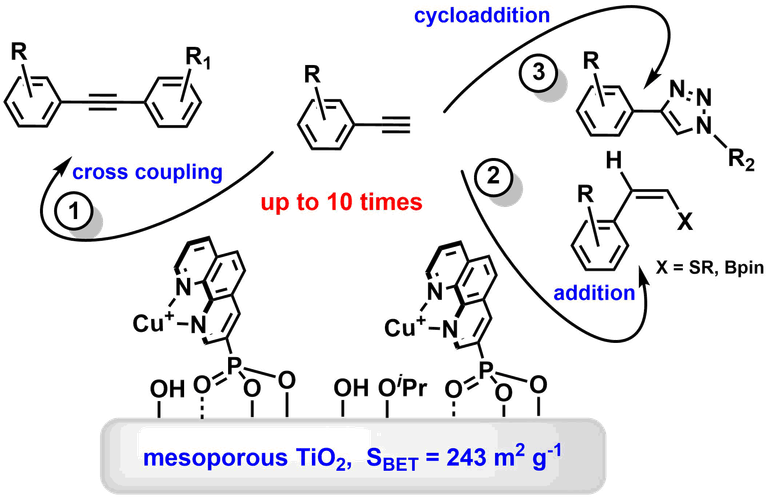Heterogenization of transition-metal complexes
Immobilization of homogeneous catalysts onto solid supports is one of the key objectives in the development of sustainable processes for the production of fine chemicals. Extensive studies are aimed at the simplification of the products purification, recycling expensive catalysts, search for an increase in the catalyst stability and generation of the shape selectivity by means of catalytic sites isolation. However, heterogenized catalysts are still rarely used in industry reflecting a crucial importance of well-understood but ill-solved problems related to these materials such as a decrease of catalytic activity and selectivity in comparison with homogeneous complexes, or leaching, to which heterogeneous catalysts are prone.
We are exploring synthetic approaches to reusable multi-process and multi-functional heterogenized catalysts by designing and preparing porous hybrid organic-inorganic materials based on air-stable metal complexes with nitrogen-donating ligands. Our synthetic strategy relies on the immobilization of the metallocomplexes with 1,10-phenanthrolines and porphyrins bearing carboxylic and phosphonic acid groups are shown in Figure 1 (Synthesis 2012, 44 (24), 3805-3810; Eur. J. Org. Chem. 2016, (28), 4881-4892; Eur. J. Org. Chem. 2019, (20), 3146-3162). For instance, the preparation of MOFs and composite materials based on nanosized MOF is investigated. Moreover, grafting of the complexes onto porous metal oxides and silica bearing isolated titania sites or subnano-TiO2 clusters is also studied. Another approach relies on the preparation of porous sol-gels bearing polyphosphonates.

Figure 1. Examples of hybrid organic-inorganic materials based on transition-metal complexes with nitrogen-donating ligands for catalysis.
These strategies combine following potential advantages:
1) thermodynamic stability of metal chelates with phenanthroline and porphyrin ligands;
2) their unique catalytic efficiency and versatility;
3) the linkage of complexes to solid supports by strong coordinative bonds;
4) excellent mechanical, thermal and chemical properties of the inorganic supports.
We are interesting to determine different parameters which are influenced on the porosity of the resulting materials. These studies focuse on the preparation of
1) cost-effective and stable solid catalysts with macroscopic characteristics of porosity (specific surface area, pore volume) similar or superior to those of benchmark materials in this field such as functionalized zeolites and PMOs;
2) solid catalysts for tandem reactions;
3) porous catalysts for flow-continuous processes;
4) heterogenized catalysts for photochemical transformations.
The first examples of the reusable and multi-process catalysts were recently reported (Figure 2, J. Chem. Mat. A. 2017, 5 (24), 12216-12235).

Figure 2. Reusable multi-process catalyst based on Cu(I) complex with 1,10-phenanthroline.
Collaborations
Pr. I. Beleskaya (Lomonosov Moscow State University).



